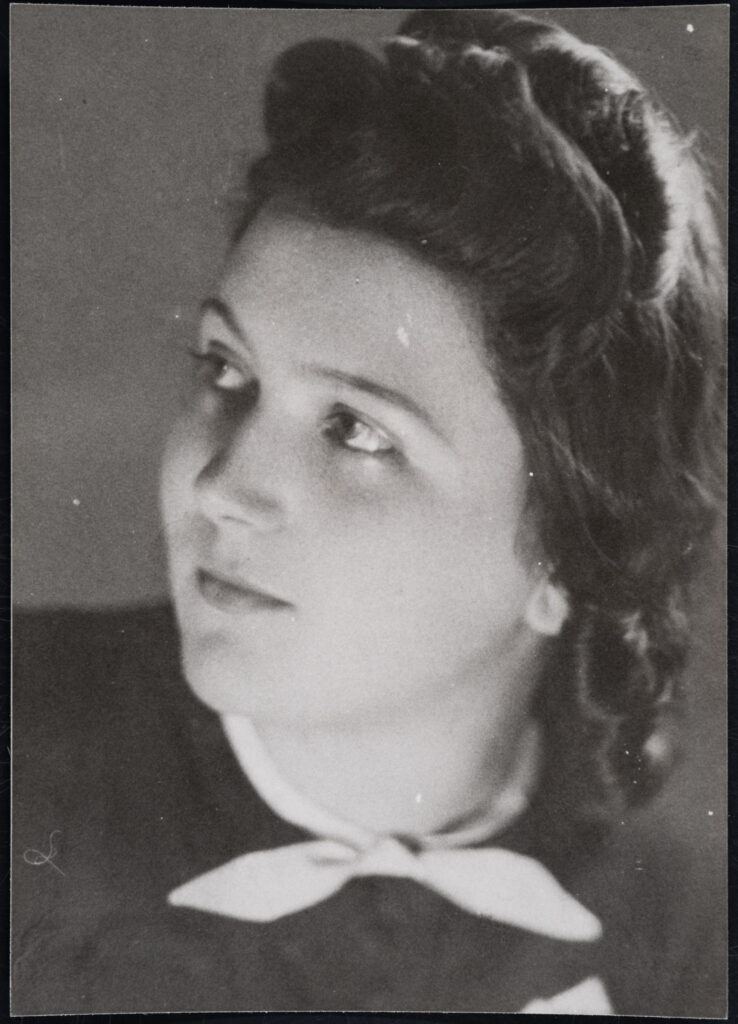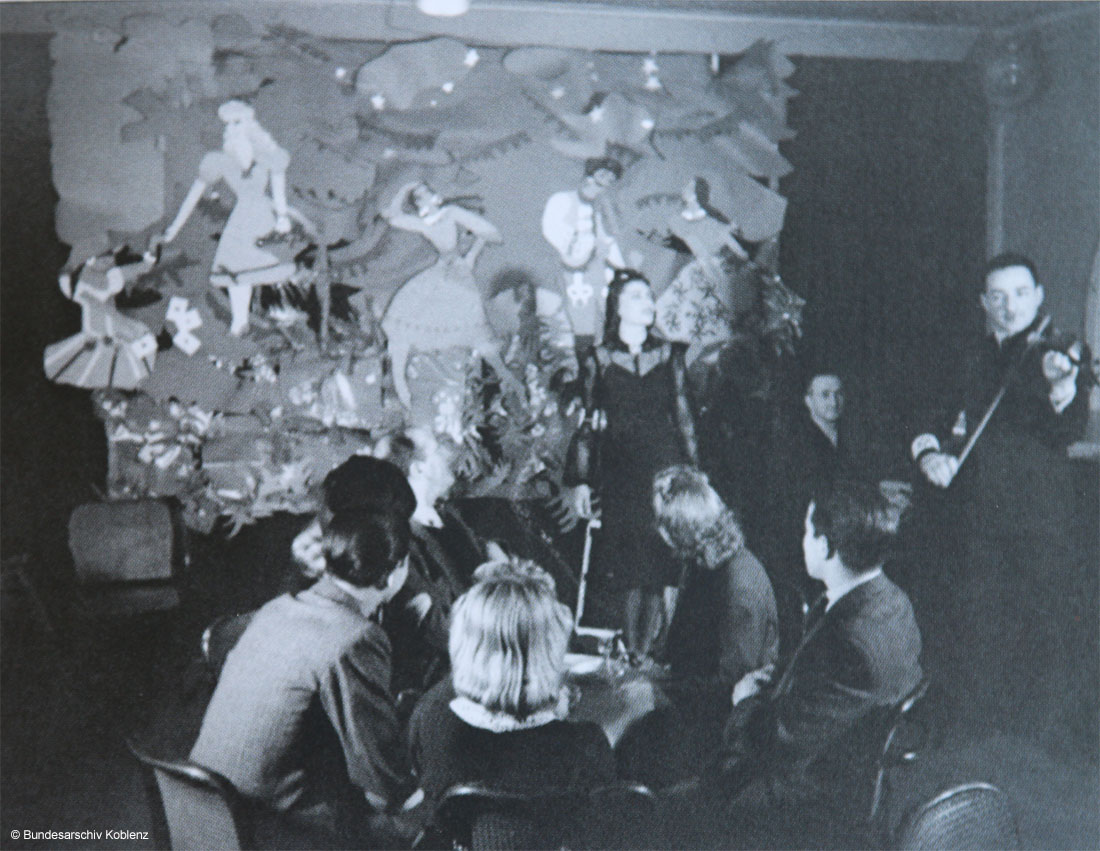Marysia Ajzensztadt (1921-1942)
A singer and pianist – “The Nightingale of the Ghetto”
Maria (Miriam) Ajzensztadt was born in Warsaw in June 1921. The nickname “Marysia” stayed with her entire life. Her mother, Fajga Goldman, took care of the home, while her father, Dawid Ajzensztadt, was a composer and renowned conductor of choirs, including at the Great Synagogue on Tłomackie Street. Before the war, the family lived at the back of that synagogue, at 7 Tłomackie Street.
Raised in a musical home, Marysia received a thorough artistic education from an early age. She studied piano under notable musicians such as Maria (Miriam) Bar and Zbigniew Drzewiecki (one of the founders of the International Fryderyk Chopin Piano Competition). Her father had intended for her to become a pianist, but ultimately she devoted herself to singing. She transferred to a vocal class and, before the outbreak of war, completed the girls’ “Jehudija” gymnasium on Długa Street in Warsaw.

Marysia Ajzensztadt | From Jewish Historical Institute the Emanuel Ringelblum collection
By September 1939, she was already 18. Despite the difficult circumstances, she continued her singing lessons until the Warsaw Ghetto was established and closed, into which she and her family were confined. It was there that her talent fully blossomed.
She debuted in December 1940 on the stage of the “Melody Palace” theater. She also performed at the “Femina” theater and other venues in the ghetto—either accompanied by a symphony orchestra or pianists, often alongside her father, who conducted the orchestra.
Winter performances by Marysia and the Jewish symphony orchestra at the “Femina” were recalled by Janina Bauman:
“In the dimly lit hall the audience sat motionless, deeply moved. Then the eighteen-year-old girl sang Schubert’s Ave Maria. She had a strong and pure voice that seemed to penetrate beyond the walls and soar high above the world and its everyday misery. People wept in the darkness, I too wept. The singer’s name was Marysia Ajzensztadt.”
Her extraordinary talent was quickly recognized by both critics and fellow musicians. Positive reviews followed—like one in Gazeta Żydowska on October 5, 1941, after a symphony concert:
“A youthful artist, still practically a child, already masters so much that she can impress even with vocal technique that singers acquire only through many years of diligent study. Her coloratura range is perfectly even, free of any effort; her intonation is precise; she has excellent rhythm, clear diction, and ease and skill in breathing technique. She possesses a gift for expressive musical interpretation that touches the sensibility of every listener.”
With a wide repertoire—from Jewish songs, operetta and opera arias, to classical and popular French and English songs—she also performed in theaters and cafés. She could be heard alongside Władysław Szpilman, Pola Braun, and Wiera Gran at the “Sztuka” café, which catered to an educated and affluent clientele.

Marysia Ajzensztadt in one of the ghetto’s cafés, photograph taken by German propaganda photographer Ludwig Knobloch | From the Bundesarchiv collection
She often performed multiple times each day to support her family.
Henryk Makower wrote in his Ghetto Diary:
“She became the public’s favorite and was widely called ‘the nightingale of the ghetto.’ […] When she began to sing with the accompaniment of the excellent pianist Rozenbaum, the hall was seized by immense enthusiasm.”
Emanuel Ringelblum also remembered Marysia in his bunker entries:
“[…] she was discovered during the war. With her songs, sung in Polish, Hebrew, and Yiddish, she simply enchanted all of Warsaw. She was the main attraction of literary and artistic events. Young, beautiful, dark-haired Marysia was the most popular person in Warsaw.”
In 1941, she became engaged to Jerzy Szapira—a physician she’d met a year earlier when he operated on her mother in a surgical hospital on Leszno Street.
By order of the Germans, Marysia participated in a propaganda film about life in the ghetto, performing in the “Sztuka” café a Hebrew song: “Eli, Eli, lama azavtani?” (“My God, My God, why have You forsaken me?”).
At the beginning of the so-called Great Deportation Action from the Warsaw Ghetto to the Treblinka death camp, carried out in summer 1942, she managed to secure employment in Schultz’s warehouse at 78 Leszno Street. Other musicians worked there, including composer and conductor Marian Neuteich. For the first days of the Aktion she was therefore protected. Ringelblum noted:
“During the blockades I met Marysia walking freely through the streets. Even for the Jewish policemen, Marysia’s name was sufficient guarantee to protect her from being caught at the Umschlagplatz.”
However, employment and proper documents did not save her. In the second or third week of deportations, in August 1942, she was killed in the ghetto, shot by the Germans. The circumstances of her death are not fully clear—several versions exist.
Edward Reicher, who described the scenes of deportation in his diary, noted:
“Whoever walked slowly or hesitated to enter the wagon was shot, like […] Marysia Ajzensztadt, a singer by divine grace, daughter of the conductor of the synagogue choir. If she had survived, she would now be a singer of world fame. […] She was killed because she hesitated to enter the wagon.”
According to Henryk Makower, she was shot on the ramp of the Umschlagplatz when she tried to resist being separated from her father:
“She began to struggle and was killed on the spot.”
Rachela Auerbach recounts yet another version: Marysia was shot in front of the building on Ceglana Street when the Germans ordered her parents to leave the apartment and proceed to the Umschlagplatz. She had a valid work pass, so she could have stayed. But she could not bear being separated from her father:
“Whether she begged, threatened, embraced him by the neck, or shielded him with her body, shouting that she wouldn’t let him go… Marysia was shot for that.”
Marysia’s name and her story endured. On July 21, 2013, a March of Remembrance—from the Umschlagplatz Monument to Tłomackie Street—was dedicated to her memory.
Bibliography:
- Archiwum Ringelbluma, t. 29, Pisma z getta Emanuela Ringelbluma. Opracowała: Joanna Nalewajko-Kulikov, Warszawa 2018
- Archiwum Ringelbluma, t. 29a, Pisma Emanuela Ringelbluma z bunkra, Warszawa 2018.
- Błaszczyk L., Żydzi w kulturze muzycznej ziem polskich, Warszawa 2014.
- Engelking B., Leociak J., Getto warszawskie. Przewodnik po nieistniejącym mieście, Warszawa 2013.
- Leociak J., Biografie Ulic, Warszawa 2018.
- Makower H., Pamiętnik z getta warszawskiego, Wrocław 1987.
- Szpilman W., Pianista, Warszawa 2022.

